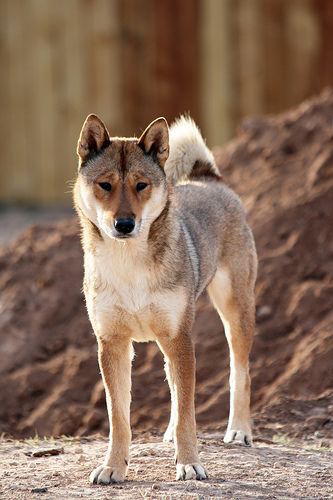
Shikoku is the smallest and least populous of Japan’s four main islands, an area known for it’s mountains, rivers and beaches. The isolation of the region greatly limited access, and thus, one of the purest dog breeds in the world, the Shikoku Dog, is the result of virtually no crossbreeding and the beneficiary of a highly pure gene pool. Shikokus (rare even in Japan) were designated as one of Japan’s national treasures in 1937. The dogs are smaller than an Akita, and larger than a Shiba Inu, and were bred to be a hunting and working dog in the Kochi Prefecture. The operative words here being “working dog.” As beautiful as these dogs are, they are considered a primitive breed strongly tied to nature, and thus are not for everyone.
Shikoku-Ken (“ken” being akin to the word, Inu,” meaning dog) have long been prized by the Japanese for their ability to be loving and loyal family members by night, but these are tenacious hunters of large game that historically hunted in packs of three to five dogs acting independently of the hunter. As such, this is an independent, inquisitive, and impulsive breed. The Shikoku has such a high working drive that the dogs will often continue to run, work and play hard long after they’re tired, and this can lead to some “crankiness.” Owners of high drive breeds who are reading this will nod knowingly as we write that a bored Shikoku is not a good thing, but neither is one who has passed their “sell by date,” figuratively speaking.
The same qualities that make the breed exception hunters are the same qualities that make the dogs poor candidates to be off lead in uncontrolled environments. Read: This isn’t the breed for you if you want a unleashed dog that will stay with you if you hike or mountain bike. The breed can be highly dog reactive, and while it’s very social and enjoys the company of other dogs, introductions and early play sessions should be supervised especially because the Shikoku’s style of play has been described as “hectic” with a lot of noise and displays of teeth.
We admire the writers who’ve shared the “inside skinny” about living with this breed because it helps prospective owners get a realistic sense if they can handle an independent, high drive breed of dog. That said the Shikoku has been recorded in the AKC’s Foundation Stock Service since 2014
Image of precious “Loa,” bred by Katja Weber and loved by Brad Anderson, shared with the kind consent of the owner

I have owned two Akitas…the first one passed away two months shy of 12 yrs old, I can not say enough about him, Koto was a truly fabulous dog in every way, with my children, other dogs in the family, cats…sweet & loving
My second one will be 6 in a couple months & going strong, …wonderful with the grandkids now, our other dogs again, cats & horses, well socialized & so sweet & handsome – having said that their one fault in my experience is that they are incredibly stubborn, they will ‘listen’ when they are ready to, not necessarily when you call or ask something of them…cannot have mine off leash as they would be gone until they are ready to come back, unlike my Rottie & Corgi who are always off line
This is my only complaint with them
From what I have read the Shikoku has the same tendencies but how do they compare to an Akita in other aspects?
I hope to have my boy Thor for a good long time yet but am also getting older & a somewhat smaller version might interest me down the road…
Thanks! 😊
Fascinating! I’d never heard of this breed!